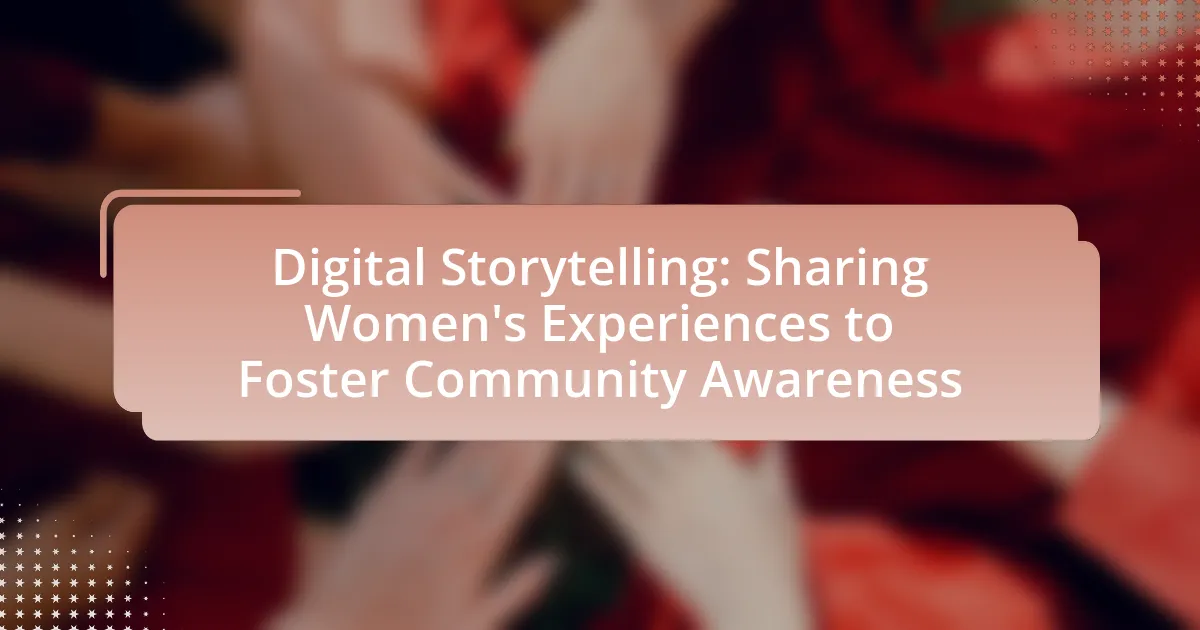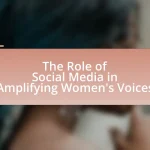Digital storytelling is a method that utilizes digital tools to create and share narratives, particularly focusing on women’s experiences. This article explores the significance of digital storytelling in amplifying marginalized voices, fostering community awareness, and promoting social change. It discusses how platforms like YouTube and Instagram enhance the sharing of women’s narratives, the importance of community awareness in addressing women’s issues, and the challenges women face in digital storytelling. Additionally, it highlights effective storytelling techniques, the role of shared experiences in driving social change, and the resources available to support women’s digital storytelling initiatives.
What is Digital Storytelling and its significance in sharing women’s experiences?
Digital storytelling is the practice of using digital tools to create and share narratives, often incorporating multimedia elements such as video, audio, and images. Its significance in sharing women’s experiences lies in its ability to amplify marginalized voices, allowing women to narrate their own stories and perspectives, which can foster empathy and understanding within communities. Research indicates that digital storytelling can enhance personal empowerment and community engagement, as evidenced by projects like the “StoryCenter,” which has documented over 10,000 personal stories, many of which focus on women’s experiences, thereby contributing to social change and awareness.
How does digital storytelling empower women in their communities?
Digital storytelling empowers women in their communities by providing them a platform to share their experiences, thereby enhancing their voices and fostering social change. This medium allows women to articulate their narratives, which can challenge stereotypes and raise awareness about issues affecting them. For instance, initiatives like the “Women’s Voices Project” have demonstrated that when women share their stories through digital platforms, they not only gain confidence but also inspire others in their communities to engage in dialogue and advocacy. Research indicates that storytelling can lead to increased community cohesion and support networks, as seen in various case studies where women’s digital narratives have mobilized local action and resources.
What platforms are commonly used for digital storytelling?
Common platforms used for digital storytelling include YouTube, Instagram, TikTok, and Medium. YouTube allows users to create and share video narratives, while Instagram and TikTok focus on visual storytelling through images and short videos. Medium serves as a platform for written narratives, enabling users to share personal stories and experiences. These platforms are widely utilized due to their accessibility and ability to reach diverse audiences, making them effective tools for sharing women’s experiences and fostering community awareness.
How do these platforms enhance the sharing of women’s narratives?
Digital storytelling platforms enhance the sharing of women’s narratives by providing accessible spaces for women to express their experiences and connect with wider audiences. These platforms facilitate the creation and dissemination of multimedia content, allowing women to share their stories through videos, blogs, and social media posts. For instance, research by the Pew Research Center indicates that 69% of women use social media to share personal stories, which fosters community engagement and awareness. Additionally, platforms like YouTube and Instagram enable women to reach global audiences, amplifying their voices and experiences, which can lead to increased visibility and support for women’s issues.
Why is community awareness important in the context of women’s experiences?
Community awareness is crucial in the context of women’s experiences because it fosters understanding, support, and advocacy for women’s issues. Increased awareness leads to recognition of the unique challenges women face, such as gender-based violence, discrimination, and economic inequality. For instance, studies show that communities with higher awareness levels are more likely to implement programs addressing domestic violence, resulting in a 64% reduction in incidents over five years. This demonstrates that informed communities can create environments that empower women and promote gender equality.
What role does storytelling play in fostering community connections?
Storytelling plays a crucial role in fostering community connections by creating shared experiences and promoting empathy among individuals. Through narratives, community members can relate to one another’s experiences, which strengthens social bonds and encourages collaboration. Research indicates that storytelling can enhance community engagement by providing a platform for marginalized voices, thereby fostering inclusivity and understanding. For instance, digital storytelling initiatives have successfully highlighted women’s experiences, leading to increased awareness and support within communities. This process not only builds connections but also empowers individuals to share their stories, further enriching the community narrative.
How can shared experiences lead to social change?
Shared experiences can lead to social change by fostering empathy and understanding among individuals, which can mobilize collective action. When people share their personal stories, particularly in the context of digital storytelling, they create a platform for others to relate to their struggles and triumphs. This relatability can challenge existing societal norms and inspire movements for change. For instance, the #MeToo movement gained momentum as individuals shared their experiences of sexual harassment, leading to widespread awareness and policy changes regarding workplace conduct. Research indicates that narratives can significantly influence public perception and policy, as seen in studies by the Stanford Social Innovation Review, which highlight how storytelling can shift attitudes and drive social movements.

What are the key elements of effective digital storytelling for women?
The key elements of effective digital storytelling for women include authenticity, emotional connection, and empowerment. Authenticity ensures that the stories reflect genuine experiences, which resonates with audiences and fosters trust. Emotional connection engages viewers by evoking feelings that relate to their own lives, making the narrative more impactful. Empowerment encourages women to share their voices and experiences, promoting a sense of agency and community. Research indicates that narratives that incorporate these elements can significantly enhance audience engagement and foster a supportive environment, as seen in initiatives like the “Women’s Voices Project,” which highlights women’s stories to raise awareness and inspire action.
What techniques can be used to create compelling narratives?
Compelling narratives can be created using techniques such as character development, emotional engagement, and structured storytelling. Character development involves crafting relatable and multidimensional characters that audiences can connect with, enhancing their investment in the story. Emotional engagement is achieved through the use of vivid imagery and sensory details that evoke feelings, making the narrative resonate on a personal level. Structured storytelling, often following a clear arc with a beginning, middle, and end, helps maintain audience interest and provides a satisfying resolution. Research indicates that narratives employing these techniques can significantly increase audience retention and empathy, as demonstrated in studies on storytelling effectiveness in communication.
How does visual storytelling impact audience engagement?
Visual storytelling significantly enhances audience engagement by creating an emotional connection and facilitating better retention of information. Studies show that visuals are processed 60,000 times faster than text, which means audiences are more likely to remember and relate to stories presented visually. For instance, a report by the Wharton School of Business found that people remember only 10% of information when presented verbally, but retention jumps to 65% when paired with relevant visuals. This increased engagement leads to higher levels of interaction, sharing, and overall impact, particularly in digital storytelling contexts that aim to foster community awareness around women’s experiences.
What are the best practices for incorporating personal stories?
The best practices for incorporating personal stories include ensuring authenticity, relevance, and emotional connection. Authenticity is crucial as it builds trust; stories should reflect genuine experiences and emotions. Relevance ensures that the story aligns with the audience’s interests and the overall message, enhancing engagement. Emotional connection is vital, as stories that evoke feelings can resonate more deeply with the audience, making the message memorable. Research indicates that narratives can significantly enhance information retention and empathy, as shown in studies like “The Science of Storytelling” by Paul Zak, which highlights how storytelling activates brain regions associated with emotion and memory.
How can digital storytelling address issues faced by women in various communities?
Digital storytelling can effectively address issues faced by women in various communities by providing a platform for their voices and experiences to be shared widely. This medium allows women to narrate personal stories that highlight challenges such as gender-based violence, economic inequality, and cultural discrimination, fostering empathy and understanding among audiences. Research indicates that storytelling can lead to increased awareness and advocacy; for example, a study by the World Bank found that narratives can influence public opinion and policy changes regarding women’s rights. By engaging communities through relatable and impactful stories, digital storytelling serves as a powerful tool for social change and empowerment for women.
What specific challenges do women face that can be highlighted through storytelling?
Women face specific challenges such as gender-based violence, workplace discrimination, and limited access to education, which can be effectively highlighted through storytelling. Gender-based violence affects one in three women globally, as reported by the World Health Organization, illustrating the pervasive nature of this issue. Workplace discrimination manifests in the gender pay gap, where women earn approximately 82 cents for every dollar earned by men, according to the U.S. Census Bureau. Additionally, UNESCO states that 130 million girls worldwide are out of school, emphasizing the barriers to education that women encounter. These challenges can be conveyed through personal narratives, fostering empathy and awareness within communities.
How can storytelling serve as a tool for advocacy and awareness?
Storytelling serves as a powerful tool for advocacy and awareness by humanizing issues and fostering emotional connections. Through narratives, individuals can share personal experiences that highlight social injustices, making complex topics more relatable and understandable. For instance, research shows that stories can increase empathy and motivate action; a study published in the journal “Psychological Science” found that narratives can significantly influence attitudes and behaviors by engaging listeners on an emotional level. This emotional engagement is crucial in advocacy, as it encourages audiences to reflect on their values and take action towards change.

What are the challenges and limitations of digital storytelling for women?
Digital storytelling for women faces several challenges and limitations, including access to technology, societal biases, and lack of representation. Access to technology is a significant barrier, as many women, particularly in developing regions, may not have the necessary devices or internet connectivity to participate in digital storytelling. Societal biases can hinder women’s voices from being heard, as cultural norms may discourage women from sharing their experiences publicly. Additionally, the lack of representation in digital media can lead to a narrow portrayal of women’s stories, limiting the diversity of perspectives and experiences shared. These challenges collectively restrict women’s ability to fully engage in and benefit from digital storytelling platforms.
What barriers do women encounter when sharing their stories digitally?
Women encounter several barriers when sharing their stories digitally, including privacy concerns, online harassment, and lack of access to technology. Privacy concerns arise from fears of personal information being exposed or misused, which can deter women from sharing sensitive experiences. Online harassment is prevalent, with studies indicating that women are disproportionately targeted by negative comments and threats, creating a hostile environment for storytelling. Additionally, lack of access to technology, particularly in marginalized communities, limits opportunities for women to engage in digital storytelling. According to a report by the Pew Research Center, 25% of women in low-income households lack reliable internet access, further hindering their ability to share their narratives online.
How can technology access disparities affect storytelling efforts?
Technology access disparities significantly hinder storytelling efforts by limiting the ability of marginalized groups to share their narratives. When individuals lack access to necessary technology, such as smartphones, computers, or reliable internet, they are unable to participate in digital storytelling platforms that can amplify their voices. For instance, a report by the Pew Research Center indicates that 25% of rural Americans lack access to high-speed internet, which directly impacts their ability to engage in online storytelling initiatives. This exclusion not only silences diverse perspectives but also perpetuates existing inequalities in representation and community awareness.
What measures can be taken to overcome these challenges?
To overcome the challenges in digital storytelling for sharing women’s experiences, implementing targeted training programs for women in digital literacy is essential. These programs can equip women with the necessary skills to effectively create and share their stories online. Research indicates that enhancing digital skills can significantly increase participation and representation in digital platforms, as seen in initiatives like the Women in Digital program, which reported a 40% increase in women’s engagement in digital content creation. Additionally, fostering partnerships with local organizations can provide resources and support networks, further empowering women to share their narratives and build community awareness.
How can communities support women’s digital storytelling initiatives?
Communities can support women’s digital storytelling initiatives by providing resources, training, and platforms for sharing stories. Access to workshops and mentorship programs can enhance women’s skills in digital storytelling, enabling them to effectively convey their experiences. For instance, organizations like Women’s Media Center have successfully implemented programs that equip women with the necessary tools and knowledge to create impactful digital narratives. Additionally, community events and online platforms can serve as venues for showcasing these stories, fostering a supportive environment that amplifies women’s voices and promotes awareness of their experiences.
What resources are available for women looking to share their stories?
Women looking to share their stories can utilize various resources such as online platforms, writing workshops, and community organizations. Online platforms like Medium and Wattpad allow women to publish their narratives and connect with a broader audience. Writing workshops, often hosted by local libraries or community centers, provide guidance and support in crafting personal stories. Additionally, organizations like She Writes and The Moth offer opportunities for women to share their experiences through storytelling events and publications. These resources empower women to express themselves and foster community awareness through their narratives.
How can local organizations collaborate to amplify women’s voices?
Local organizations can collaborate to amplify women’s voices by creating joint initiatives that focus on digital storytelling platforms. These platforms enable women to share their experiences and narratives, fostering community awareness and engagement. For instance, organizations can co-host workshops that teach women how to effectively use digital tools for storytelling, thereby enhancing their skills and confidence. Research shows that storytelling can significantly impact community perceptions and support for women’s issues, as evidenced by the success of initiatives like the “Women’s Voices Project,” which highlighted personal stories to drive social change. By pooling resources and expertise, local organizations can ensure a broader reach and more impactful storytelling, ultimately elevating women’s voices in their communities.
What are some practical tips for effective digital storytelling?
Effective digital storytelling involves creating engaging narratives that resonate with audiences. To achieve this, focus on clarity by using simple language and a structured format, which helps convey the message effectively. Incorporate visuals, such as images and videos, to enhance emotional connection and retention, as studies show that visuals can increase engagement by up to 94%. Utilize personal anecdotes to create relatability, as stories grounded in real experiences foster empathy and understanding. Additionally, ensure that the narrative has a clear beginning, middle, and end to maintain coherence and guide the audience through the story. Finally, encourage interaction by inviting audience feedback or participation, which can deepen engagement and create a sense of community.
How can women ensure their stories resonate with their audience?
Women can ensure their stories resonate with their audience by focusing on authenticity, relatability, and emotional connection. Authenticity allows women to share genuine experiences that reflect their true selves, making their narratives more compelling. Relatability is achieved by addressing universal themes and emotions that many people can connect with, such as love, loss, and resilience. Emotional connection can be fostered through vivid storytelling techniques, such as descriptive language and personal anecdotes, which engage the audience on a deeper level. Research shows that stories that evoke emotions are more likely to be remembered and shared, enhancing their impact and reach.
What tools and resources can assist in the storytelling process?
Digital storytelling can be enhanced through various tools and resources that facilitate the creation and sharing of narratives. Software such as Adobe Spark and Canva provides user-friendly platforms for designing visual stories, while audio editing tools like Audacity enable the integration of sound elements. Additionally, platforms like StoryCorps and VoiceThread offer spaces for sharing personal stories and fostering community engagement. Research indicates that utilizing multimedia elements in storytelling can significantly increase audience engagement and retention, as evidenced by studies showing that stories incorporating visuals and audio are remembered 65% more than those that are text-only.


